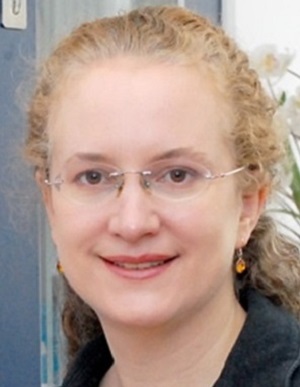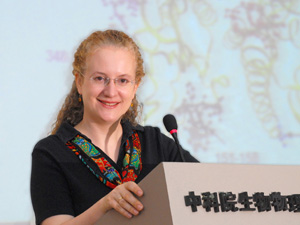

中国科学院生物物理研究所,生物大分子全国重点实验室,研究组长

1989 - 1992 英国剑桥大学化学系获学士学位
1993 - 1996 英国剑桥大学化学系获博士学位
1996 - 1997 英国剑桥大学化学系博士后
1997 - 2000 英国剑桥大学化学系研究人员
2000 - 2003 中国科学院生物物理研究所访问学者,英国皇家学会资助
2003 - 至今 中国科学院生物物理研究所研究组长,中国科学院生物物理研究所学术交流与合作委员会委员
蛋白质的结构与功能密切相关,其错误折叠和聚集往往引起功能的异常,分子伴侣能辅助蛋白质折叠、抑制错误折叠和聚集,是细胞内蛋白质质量控制体系的重要组成部分。本实验室采用多种研究技术手段,特别是单分子荧光技术,开展蛋白质折叠、修饰与质量控制的研究,当前主要研究方向包括:
1. 单分子荧光技术研究淀粉样蛋白折叠和组装机制
单分子技术可揭示生物大分子状态分布及动态变化信息,捕捉混合体系内低含量组分。我们采用单分子荧光技术深入研究淀粉样蛋白从可溶态转化为不可溶纤维态的分子机制,并试图揭示致病性与功能性淀粉样纤维的毒性差异原因。
2. 分子伴侣的构象动态和翻译后修饰与功能的关系
我们采用生化和细胞生物学方法、单分子技术、结构生物学技术等多种手段,深入研究Hsp70及Hsp40等分子伴侣调控蛋白质折叠和错误折叠的机制,以及翻译后修饰对分子伴侣结构和功能的影响,试图阐明分子伴侣在蛋白质质量控制体系中发挥功能的分子机制。
3. 基于淀粉样纤维的功能性生物纳米材料开发
淀粉样纤维具有高强度和稳定性,以及组装和功能可调控等特点,是一类具有潜在应用价值的生物纳米材料。我们研究淀粉样纤维的力学性能与其组装机制的关系,并利用淀粉样纤维的独特性来设计新型的纳米材料。
发表论文(Selected from a total of 85 papers)
1. Wen, J., Hong, L., Krainer G., Yao, Q.Q., Knowles T.P.J., Wu, S.* & Perrett, S.* (2021) Conformational expansion of Tau in condensates promotes irreversible aggregation. J. Am. Chem. Soc. In press.
2. Zhang, H., Gong, W., Wu, S., & Perrett, S.* (2021) Studying protein folding in health and disease using biophysical approaches. Emerg. Top. Life Sci. 5, 29-38.
3. Yang, J., Gong, W., Wu, S., Zhang, H.* & Perrett, S.* (2021) PES inhibits human inducible Hsp70 by covalent targeting of cysteine residues in the substrate binding domain. J. Biol. Chem. 296, 100210.
4. Yang, J., Perrett, S., Wu, S.* (2021) Single molecule characterization of amyloid oligomers. Molecules 26, 948.
5. Yao, X., Chen, C., Wang, Y., Dong S., Liu, Y.J., Li, Y., Cui, Z., Gong, W., Perrett, S., Yao, L., Lamed, R., Bayer, E.A., Cui, Q., Feng, Y.G.* (2020) Discovery and mechanism of a pH-dependent dual-binding-site switch in the interaction of a pair of protein modules. Science Advances 6, eabd7182.
6. Yang, J., Dear, A.J., Yao, Q., Liu, Z., Dobson, C.M., Knowles, T.P.J., Wu, S.* & Perrett, S.* (2020) Amelioration of aggregate cytotoxicity by catalytic conversion of protein oligomers into amyloid fibrils. Nanoscale 12, 18663-18672.
7. Yang, J., Zhang, H.*, Gong, W., Liu, Z., Wu, H., Hu, W., Chen, X., Wang, L., Wu, S., Chen, C.* & Perrett, S.* (2020) S-Glutathionylation of human inducible Hsp70 reveals a regulatory mechanism involving the C-terminal α-helical lid. J. Biol. Chem. 295, 8302-8324.
8. Wu, S. Hong, L., Wang, Y., Yang, J., Yang J., Zhang, H. & Perrett, S.* (2020) A kinetic view of the conformational cycle of Hsp70 reveals the importance of the dynamic and heterogeneous nature of Hsp70 for its function. PNAS 117, 7814-7823.
9. Dear, A.J., Michaels, T.C.T., Meisl, G., Klenerman, D., Wu, S., Perrett, S., Linse, S., Dobson, C.M., and Knowles, T.P.J.* (2020) Kinetic diversity of amyloid oligomers. PNAS 117, 12087-12094.
10. Yao, Q., Hong, L., Wu, S.* & Perrett, S.* (2020) Distinct microscopic mechanisms for the accelerated aggregation of pathogenic Tau mutants revealed by kinetic analysis. PhysChemChemPhys 22, 241-7249.
11. Yang, J., Dear, A.J., Michaels, T.C.T., Dobson, C.M., Knowles, T.P.J.K.*, Wu, S.* & Perrett, S.* (2018). Direct observation of oligomerization by single molecule fluorescence reveals amulti-step aggregation mechanism for the yeast prion protein Ure2. J. Am. Chem. Soc., 140, 2493-2503.
12. Gong, W., Hu, W., Xu, L., Wu, H., Wu, S., Zhang, H., Wang, J., Jones, GW.* & Perrett, S.* (2018).The C-terminal GGAP motif of Hsp70 mediates substrate recognition and stress response in yeast. J. Biol. Chem. 293, 17663-17675.
13. Xu, L., Gong, G.*, Cusack, S.A., Wu, H., Loovers, H.M., Zhang, H., Perrett, S. & Jones G.W.* (2018). The β6/β7 region of the Hsp70 substrate-binding domain mediates heat shock response and prion propagation. Cell. Mol. Life Sci., 75, 1445-1459.
14. Lou, F., Yang, J., Wu, S.* & Perrett, S.* (2017). A co-expression strategy to acheive labeling of individual subunits within a dimeric protein for single molecule analysis. ChemComm 53, 7971-8094.
15. Yang, W., Willemse J., Sawyer E.B., Lou F., Gong, W., Zhang, H., Gras, S.L.*, Claessen, D.* & Perrett, S.* (2017). The propensity of the bacterial rodlin protein RdlB to form amyloid fibrils determines its function in Streptomyces coelicolor. Scientific Reports 7, 42867.
16. Zhang, H., Yang, J., Si, W., Gong, W., Chen, C.* & Perrett, S.* (2016). Glutathionylation of the bacterial Hsp70 chaperone DnaK provides a link between oxidative stress and the heat shock response. J. Biol. Chem. 291, 6967-6981.
17. Zhou, X.M., Shimanovich, U., Herling, T.W., Wu, S., Dobson, C.M., Knowles, T.P.J.* & Perrett, S.* (2015) Enzymatically-active microgels from self-assembling protein nanofibrils for microflow chemistry. ACS Nano 9, 5772-5781.
18. Rees, J.S., Li, X.W., Perrett, S.*, Lilley, K.S.* & Jackson, A.P.* (2015) Protein neighbours and proximity proteomics. Molecular & Cellular Proteomics 14, 2848-2856. (Invited Review)
19. Wu, H., Gong, W., Yao, X., Wang, J., Perrett, S.* & Feng, Y.* (2015). Evolutionarily conserved binding of translationally-controlled tumor protein to eukaryotic elongation factor 1B. J. Biol. Chem. 290, 8694-710.
10. Zhou, X.M., Entwistle, A., Zhang, H., Jackson, A.P., Mason, T.O., Shimanovich, U., Knowles, T.P.J., Smith, A.T., Sawyer, E.B.* & Perrett, S.* (2014). Self-assembly of amyloid fibrils that display active enzymes. ChemCatChem 6, 1961-1968.
21. Li, X.W., Rees, J.S., Lilley, K.S., Howard, J.A., Zhang, H., Peng, X., Hamaia, S.W., Farndale, R.W., Perrett, S.* & Jackson, A.P.* (2014). New insights into the DT40 B cell receptor cluster using a proteomic proximity labeling assay. J. Biol. Chem. 289, 14434-14447. (Highlighted as a "Key Scientific Article" in Global Medical Discovery. Highlighted in Bulletin of the Chinese Academy of Sciences. Chapter invited for Current Protocols. Review invited for Mol. Cell. Proteom.)
22. Gong, W, Wang, J., Perrett, S.* & Feng, Y.* (2014). RBBP1 has an interdigitated double Tudor domain with DNA-binding activity. J. Biol. Chem. 289, 4882-4895.
23. Xu, L.Q., Wu, S., Buell, A.K., Cohen, S.I.A., Chen, L.J., Hu, W.H., Cusack, S.A., Itzhaki, L.S., Zhang, H.*, Knowles, T.P.J., Dobson, C.M., Welland, M.E., Jones, G.W. & Perrett S.* (2013). Influence of specific Hsp70 domains on Ure2 fibril formation in vitro. Phil. Trans. Roy. Soc. B 368, 20110410. (Invited submission)
24. Zhu, M., Perrett, S. & Nie, G.* (2013). Understanding the particokinetics of engineered nanomaterials for safe and effective therapeutic applications. SMALL 9, 1619-34.
25. Truman, A.W., Kristjansdottir, K., Wolfgeher, D., Hasin, N., Polier, S., Zhang, H., Perrett, S., Prodromou, C., Jones, G.W. & Kron, S.J.* (2012). CDK-dependent Hsp70 phosphorylation controls G1 cyclin abundance and cell cycle progression. CELL 151, 1308-1318.
26. Sawyer, E.B., Claessen D., Gras, S.L. & Perrett, S.* (2012) Exploiting amyloid: how and why bacteria use cross-β fibrils. Biochem. Soc. Trans. 40, 728-34. (Invited Review)
27. Chen, L.J., Sawyer, E.B. & Perrett, S.* (2011). The yeast prion protein Ure2: insights into the mechanism of amyloid formation. Biochem. Soc. Trans. 39, 1359-1364. (Invited review)
28. Li, Y., Zhou, Y., Wang, H.Y., Perrett, S., Zhao, Y.,* Tang, Z.* & Nie, G.* (2011). Chirality of gluthathione surface coating affects the cytotoxicity of quantum dots. Angew. Chem. Int. Ed. Engl. 50, 5860-5864. (Highlighted in Nature Materials (2011) 10, 480.)
29. Wang, Y.Q., Buell, A.K., Wang, X.Y., Welland M.E., Dobson, C.M., Knowles, T.P.J.* & Perrett, S.* (2011). Relationship between prion propensity and the rates of individual molecular steps of fibril assembly. J. Biol. Chem. 286, 12101-12107. (On the Cover.)
30. Zhang, H., Xu, L.Q. & Perrett, S.* (2011). Studying the effects of chaperones on amyloid fibril formation. Methods 53, 285-294. (Invited Review)
31. Zhang, Z.R. & Perrett, S.* (2009). Novel glutaredoxin activity of the yeast prion protein Ure2 reveals a native-like dimer within fibrils. J. Biol. Chem. 284, 14058-14067.
32. Fei, L. & Perrett, S.* (2009). Disulfide bond formation significantly accelerates the assembly of Ure2p fibrils due to proximity of a potential amyloid stretch. J. Biol. Chem. 284, 11134-11141.
33. Zhang, H., Loovers, H.M., Xu, L.Q., Wang, M., Rowling, P.J.E., Itzhaki, L.S., Gong, W., Zhou, J.M., Jones, G.W. & Perrett, S.* (2009). Alcohol oxidase (AOX1) from Pichia pastoris is a novel inhibitor of prion propagation and a potential ATPase. Mol. Microbiol. 71, 702-716.
34. Perrett, S.* & Jones, G.W.* (2008). Insights into the mechanism of prion propagation. Curr. Opin. Struct. Biol. 18, 52-59. (Invited Review)
35. Gao, L., Zhuang, J., Nie, L., Zhang, J., Gu, N., Wang, T., Perrett, S.* & Yan, X.* (2007). Intrinsic peroxidase-like activity of ferromagnetic nanoparticles. Nature Nanotechnology 2, 577-583. (Article)
Books
1. Perrett S., A.K. Buell & T.P.J.K. Knowles (Editors) “Biological and Bio-inspired Nanomaterials”, 2019, Springer Nature. ISBN: 978-981-13-9790-5.
2. Sunde M., Chapman M., Otzen D. & Perrett S. (Editors), “Functional Amyloids” Biomacromolecules vol. 7, 2017, MDPI. ISSN: 2218-273X
3. Perrett S. (Editor), “Amyloids in Health and Disease” Essays in Biochemistry vol. 56 (248 pages), 2014, Portland Press. ISBN: 781855781924
Book Chapters
1. Roode, L.W.Y., Schimanovich, U., Wu, S., Perrett, S. & Knowles, T.P.J. “Protein microgels from amyloid fibril networks.” Biological and Bio-inspired Nanomaterials, Advances in Experimental Medicine and Biology vol. 1174 (Chapter 7, p. 223-263), 2019, Springer Nature.
2. Rees, J.S., Li, X.W., Perrett, S., Lilley, K.S. & Jackson, A.P. “Selective proteomic proximity labeling assay using tyramide (SPPLAT): A quantitative method for the proteomic analysis of localised membrane-bound protein clusters.” Current Protocols in Protein Science vol. 88 (p.19.27.1-19.27.18), 2017, Wiley.
(资料来源:柯莎研究员,2021-07-02)